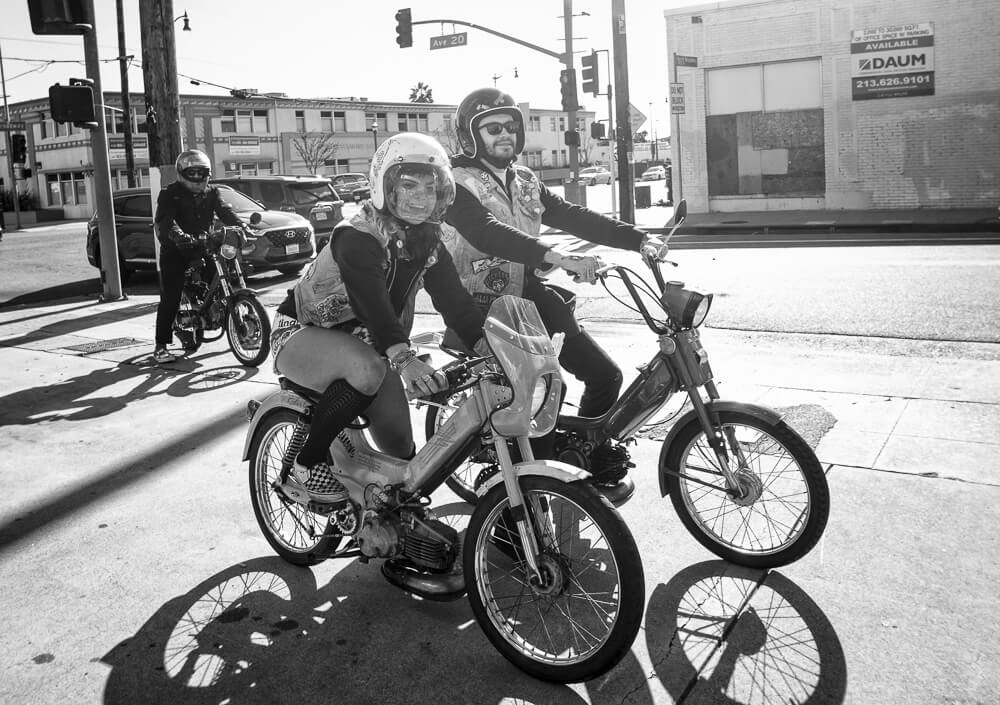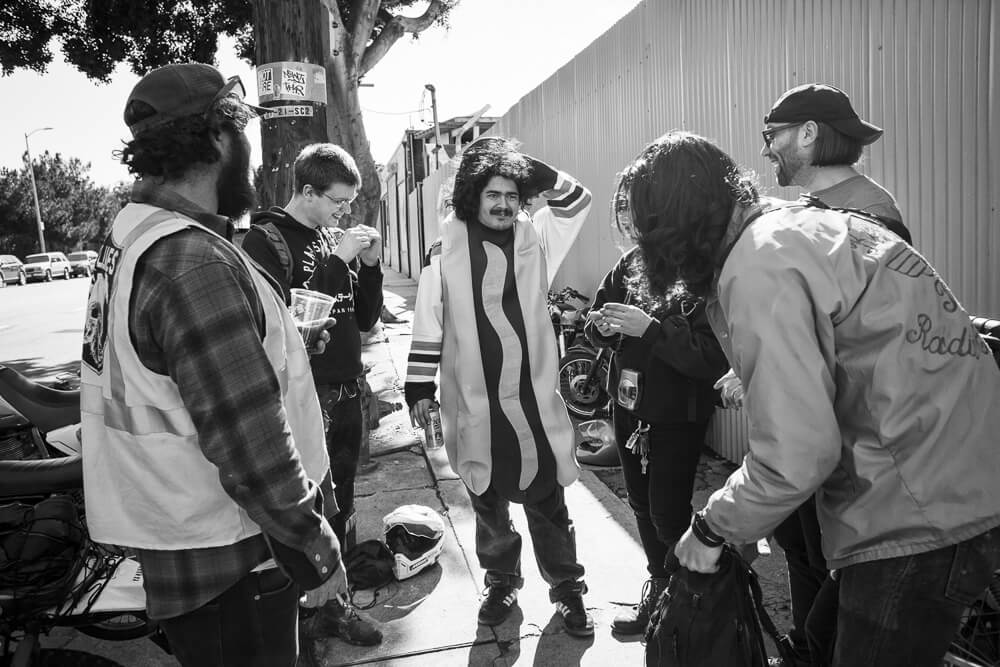The Woolly Bullies have been tearing up local streets for over a decade. One reporter went for a ride with the motley crew at their annual rally.
In the Westlake neighborhood, on the outskirts of downtown, there lies Crawfords, a squat, yellow bar with the words “FRIED CHICKEN” and “ICE COLD BEER” painted above its doorway. On a Friday evening in February, on the grass just beyond the entrance, a yellow 1970s Puch moped leaned against the establishment’s lone bike stand. It was raining and the moped was invisible to passersby.
I was standing under the awning, sharing a cigarette with a man I had just met who wore a denim jacket affixed with dozens of pins, including two with the words “MUSTARD!” and “KETCHUP!” in a cartoonish font. He cupped his ear, then pointed to the nearby intersection.
“That’s probably the boys from New Orleans,” he said.
Six mopeds suddenly rounded the corner, their loud two-stroke engines buzzing like a swarm of bees. Their riders pulled up in front of the bar, and then onto the sidewalk, where they parked their vehicles before walking inside. I stubbed out the cigarette and followed them in.
Gang paraphernalia: Most moped clubs refer to themselves as “gangs,” but the term is relatively tongue-in-cheek. Photo by Carrie Schreck.
They were here for Hot Dogg Party, a three-day rally organized by the Woolly Bullies, one of L.A.’s veteran moped gangs. Rallies are staple events in moped culture. They give gangs, or clubs — the terms are used interchangeably — the opportunity to host local and out-of-town riders for several days of bonding, riding and irreverence. Hot Dogg Party is the Bullies’ third official rally since their inception in 2007, though they’ve hosted a handful of “unofficial” rallies since then.
Within an hour, most of the sidewalk and adjacent parking lot had filled with customized mopeds. Their owners milled about, slightly drunk, pointing to parts and explaining adjustments they had made. Inside the bar, a member of the Woolly Bullies checked in nearly 100 registered riders for the weekend’s event.
The birth of modern moped culture can be traced back to a man named Dan Kastner and a shop in Kalamazoo, Michigan called 1977 Mopeds. In the late ’90s, he co-founded Moped Army, a website and forum where riders could talk shop and share information about upcoming rallies. Most clubs, both online and in-person, will refer to themselves as “gangs,” but the term is relatively tongue-in-cheek. A local rider in a trailer for a 2012 documentary about L.A.’s all-women moped crew, The Gaskettes, summed it up best: “You can’t really take yourself that seriously on a moped.”
The vehicles themselves are slow, loud, smoggy and comically unreliable. Most models that show up to rallies were built in the 1970s and shipped to the U.S. during the energy crisis because they get somewhere between 60-100 miles per gallon. People discover them in barns, covered with dust and cobwebs, hidden in overgrown yards and forgotten in the corners of their neighbor’s basements. As a modest mode of transportation, mopeds are essentially the opposite of the electric scooters that are strewn all over parts of Los Angeles.
How people find the community is another story. “It’s everywhere, but it’s nowhere,” one Woolly Bully told me. A boyfriend or girlfriend will bring them into the scene and pass the torch when the relationship dies out. A coworker or friend will hear that a moped has come into their possession, and invite them out to their first rally. Membership is a rotating door, and most people only hang around for a few years before moving on. In an almost mystical way, when you find a moped, moped culture finds you.
Rallies like the Woolly Bullies’ Hot Dogg Party give moped devotees the opportunity to buddy up with like minds and race through the city. Photo by Carrie Schreck.
Inside the bar, a Bully named Devo tapped my shoulder and started pointing to people. “That guy’s an architect, and she’s a graphic artist. He’s a blacksmith, and that guy is a professor up in SF,” she said. “We wouldn’t know each other if it wasn’t for mopeds.”
I introduced myself to Carrie Schreck, who the Woolly Bullies call their “historian.” She has been documenting moped culture for more than 10 years, both domestically and abroad in Croatia and Copenhagen.
“I started hearing about other groups outside of the country through social media,” Schreck said. “I would post things on Instagram and I had these followers, these international followers from everywhere, and they’d send me messages or leave comments about how they were riding in groups and that I should come see them.”
When I told her that I was interested in joining Saturday’s 60-mile ride, she offered to lend me one of her own bikes.
“Are you sure?” I asked.
“Yes,” she said. “In fact, I insist.”
In the few interactions moped riders have had with the media, they’ve been portrayed rather negatively, often as a bunch of dirty, hooligan hipsters. Most riders find these encounters hilarious. One woman at the bar recalled a Chicago radio story she heard where a talking head spent 30 minutes raving about a pack of mopeds that had descended on a hot dog stand where he and his wife were eating. He was baffled, alarmed and somehow offended. Another popular story recounts the time a Bay Area news outlet reported that “1,000 Hipsters Cross Golden Gate Bridge” – a rally that some Hot Dogg Party riders remembered fondly. The original footage can still be found on YouTube.
Gang life: From architects to blacksmiths, the Woolly Bullies are a motley crew. Photos by Carrie Schreck.
By Saturday the skies had cleared, and at around one o’clock riders began trickling into Lucky Wheels Garage, a DIY shop northeast of downtown. It was cold by L.A. standards, the temperature hovering just below 60 degrees Fahrenheit, but visibility was high and people were eager to ride. I tracked Schreck down, and she walked me to my “loaner bike” – a 2010 Tomos, all black and modified to look like a café racer.
“Come find me when we get to the first gas station,” she said. “We’ll put in .9 gallons, a little bit of oil, and then we’ll shake the shit out of it.”
She advised that I ride around the block, just to get a feel for the handling. I pulled on my helmet, walked the moped onto the street, hopped on and gunned it.
The first thing you notice is the rattle. Two-stroke engines are simple – with only two motions, they suck gas into the combustion chamber, compress and explode it, then release the exhaust fumes while filling up again. In your average car, this process takes four, slightly more discreet strokes. Then, you notice the noise. Mopeds are often, and accurately, compared to lawnmowers. When riding one, you feel exposed, conspicuous and slightly unsafe. Riding one is also a stupid amount of fun. When I pulled back into Lucky Wheels, someone saw me grinning.
“That’s called Moped Face!” they shouted.
Minutes later, around 90 mopeds idled on the street.
The plan was to ride up around Griffith Park, over to Mulholland Drive, then down Coldwater Canyon back to Sunset Boulevard, where we would stop for hot dogs and drinks at Carney’s, an old dining car turned restaurant. I pulled my bike next to a veteran Bully and waited for the signal. Then, up ahead, someone shouted. The Bully turned to me and pointed down the street: “Go, go, go!”
Everyone in L.A. knows what it’s like to commute. We drive to work, to the grocery store, to the beach, to our friends’ houses. Our experience of the city is often mediated through a windshield. When you’re in the thick of a moped pack, you not only experience the city in a new way, the city also experiences you. Cars stop and people lean out of their windows to get a better look. Pedestrians shout and film. Little kids, not knowing what they’re seeing, roar with laughter while their parents smile behind them.
Riding in a pack is an experience for both riders and locals. Photo by Carrie Schreck.
When we finally hit the canyon roads, the pack started to spread out. To our right, the San Fernando Valley fanned open. We turned south and barreled down Coldwater Canyon Avenue, like some kind of smoggy avalanche until we pulled back onto Sunset Boulevard, where it had become nighttime.
When we got back to Lucky Wheels, I was told that only seven mopeds had broken down – not bad, someone noted, considering the distance. I rode the remaining few blocks to Schreck’s apartment, where I dropped off the bike and thanked her and the Bullies for their hospitality.
“It’s such a dumb, niche thing,” she said in parting. “But if you find it interesting and fun and, secret handshake, kinda know all these other people that are having fun with it – if they’re down with this dumb thing – then they must be cool.”
On the way home, there was bumper to bumper traffic on the 101. Then, it came to a dead stop. “Damn,” I thought, “should have taken surface streets.” It was the perfect time for a moped.


